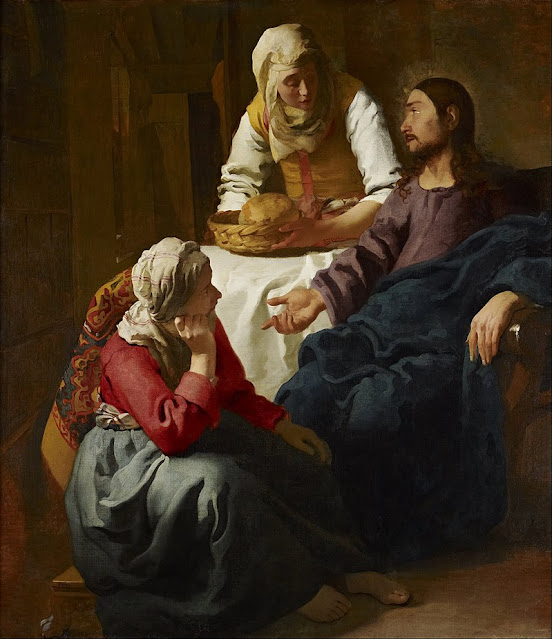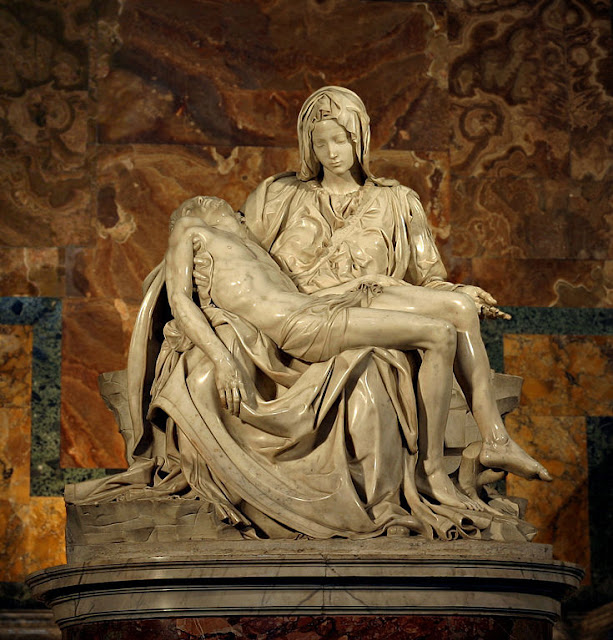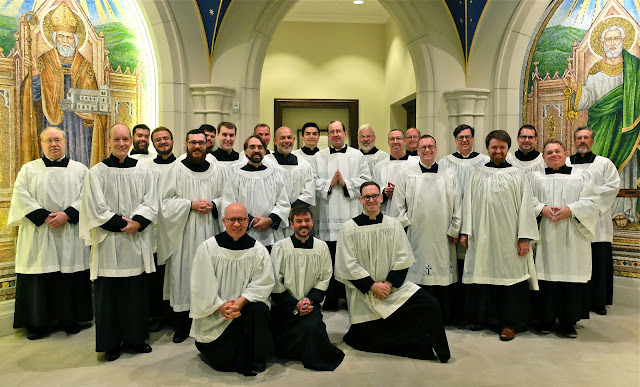Holy Receptivity | Orientation In Worship
Jesus at the home of Martha and Mary | Johannes Vermeer
Much digital ink has been spilled about the notion of active participation in the Liturgy. That same notion should read actual participation, but due to a misleading translation of the Latin participatio actuosa, Latin Rite Catholics have been subjected to an incessant barrage of activities at Mass that constitute an unfortunate layering of events that practically force people to embrace a misstated concept in an attempt to engage us in worship. More than acting out, Christ calls us to be present to him in the Liturgy.
Holy receptivity is being open-minded and willing to receive divine direction and grace. It entails fostering an open heart and mind to God's presence and teachings, which allows for spiritual growth and transformation.
Core Elements of Holy Receptivity
- Openness and Humility. Holy receptivity involves a posture of humility, acknowledging one's dependence on God and a willingness to be taught and led.
- Active listening to God's voice, whether through prayer, scripture, or the promptings of the Holy Spirit. Our thoughts, freed from sinful attractions, are guided by God toward himself.
- Submission to God's Will entails a willingness to surrender one's own will and desires to God's purpose, even when it may be challenging.
- Spiritual Transformation. Holy receptivity is not a passive state, but an active process of spiritual growth and transformation, as one's mind and heart are shaped by God's influence.
- Discernment involves developing the ability to discern God's will and guidance amidst various influences and distractions.
- Gratitude. Recognizing that all good things come from God and expressing gratitude for His blessings is an essential part of holy receptivity.
Where the Liturgy is celebrated in a reverent and rubrically vital way, i.e., in a way that is true to the nature of the Liturgy, there is little need for trite catechesis or cheerleading that seeks to turn Catholics into liturgical activists who are then preoccupied with self and externals. Yes, the mind tends to follow where the body goes, and if one is embodying the Faith, the mind tends to catch up and orient to the object of prayer. The body tends to go where the heart and mind go. If the body - by means of bowing, genuflecting, making the Sign of the Cross - is trained in meaningful prayerful gesture to embody prayer, the whole person tends to unite in prayer to God. Anything less than whole-person prayer is not Catholic. Words without action amount to lip service. Action without meaningful intent is mere sport that can lead to self aggrandizement instead of self abnegation for the love of God and neighbour.
What is the nature of the Liturgy? The Liturgy is Christ acting among the gathered assembly. He acts through the priest, speaks through Holy Scripture, he is present in those gathered in his name, and he is Present in the Holy Eucharist. We worship God the Father through Christ in the Holy Spirit. Heaven descends to earth; earth meets heaven. Time meets eternity. Eternity informs time. We are present to Jesus at the Last Supper and we are present to his death and resurrection. For our part the celebration of the Liturgy, then, should conform to the heavenly nature of the Mass, the worship of the Most Holy Trinity.
Listening
Listening is crucial to and in the Catholic Mass as it allows worshippers to actively engage with God's word and teachings. It's an essential part of both the Liturgy of the Word, where Scripture is proclaimed, and the Liturgy of the Eucharist, where the priest's words are significant. By listening attentively, individuals can deepen their faith, enter into the mysteries of the Mass, and respond to God's call in their lives.
1. Receiving God's Word
Liturgy of the Word
The readings from the Bible, especially the Gospel, are a central part of the Mass. Listening attentively allows individuals to hear God speaking to them through Scripture.
Gospel Acclamation
The singing of the Alleluia or other acclamation (Tract, Sequence) before the Gospel is a way to prepare the heart to receive the Good News.
Homily
The priest's reflection on the readings (the homily) provides further guidance and interpretation, helping to connect the ancient texts to modern life.
2. Responding to God's Call
Active Participation
Listening, even in silence, is an active form of participation in the Mass. It allows individuals to reflect on the readings and the priest's words, allowing them to be present to God and His gifts.
Interior Transformation
By actively or attentively listening and reflecting on God's word, individuals can experience an interior transformation, allowing God's grace to work within them.
Discernment
Listening can help individuals discern God's will for their lives, leading them to make choices that align with the Catholic Faith.
3. Understanding the Mysteries of the Mass
Liturgy of the Eucharist
The prayers and actions of the priest during the Liturgy of the Eucharist, such as the Consecration, are deeply rooted in Scripture and Tradition. Listening to these words helps individuals enter into the living history of the Faith, the living Presence of Christ.
Eucharistic Prayer
The priest's words during the Eucharistic Prayer, including the institution narrative, are central to the Mass and the Catholic understanding of the Eucharist. The words of consecration are Jesus' own words (St Luke 22:14-20).
Communion
Listening attentively during the distribution of Holy Communion can better dispose the worshipper to receiving Christ's Body and Blood (1 Corinthians 11:27).
4. Fostering Community
Eucharistic Fellowship
The Mass is a communal celebration where individuals gather to worship the Lord together. Listening to the readings, homily, and prayers fosters a shared experience of faith that orients Catholics to the Lord.
In essence, listening at Mass is not a passive activity but an active form of engagement that allows individuals to encounter God, deepen their faith, and participate more fully in the liturgical life of the Church.
Without first listening, all other activities can be robbed of a right orientation, and worship becomes a mere fascination with externals that may or may not induce the worshipper to dispose himself to God. At worst, attempts to induce faith amount to mere spectacle. Monsignor Charles Pope captures Pope Leo XIV's perspective on right orientation.
The answer is mystery: Pope Leo’s prophetic prescription for our ailing culture
Spectacle is from the Latin spectaculum, meaning, most commonly, “a public show.” The word emphasizes the raw act of seeing, hearing or experiencing. Generally, spectacle appeals to our senses; it is bright and loud and “in our face.” Spectacle seeks to overawe us, to entertain and please us — in some cases, to stimulate emotions and thereby capture us in some way. The ancient Romans, and many governments before and since, have used spectacle to amuse and divert the crowds, deliver messages, ensure compliance or seek allegiance.
Mystery, however, is more often found in silent meditation, in careful appreciation and in a deeper understanding based on truth, whether revealed or deeply written in our soul. Mystery does not aim to please the crowd or the individual. In mystery, the focus is not on me but on the other. Something or someone draws me out of the ordinary to a deeper place. Spectacle is about external events, while mystery emphasizes meaning, wonder and appreciation.
However, an additional distinction is important. In the secular world, a mystery is something to be solved, something that baffles us or lies undisclosed. And the usual response of the world to a mystery is to get to the bottom of it, to uncover it. Mysteries must be solved! In the Catholic world, a mystery is something that must be respected. It presupposes that there are hidden aspects of things, people and situations that extend beyond their visible, physical dimensions.
One of the best definitions of mystery I have read is by the French theologian and philosopher Jean Lacroix. Lacroix says, “Mystery is that which opens temporality and gives it depth. It introduces a vertical dimension and makes of it a time of revelation, of unveiling.”
Consider a classic example of event versus mystery: Suppose you and I are at a party, and Smith comes in the door and goes straight away to Jones and warmly shakes his hand. And I say, “Wow, look at that.” Puzzled, you say, “What’s the big deal? So what, they shook hands.” But then I tell you, “Smith and Jones have been enemies for 30 years.”
Thus, the act of shaking hands had a hidden, richer meaning beyond what meets the eye. This is mystery. There is something hidden, something accessible only to those who know and are initiated into the mystery and who come to grasp some dimension of it; it is the deeper reality of things. | Msgr. Charles Pope 30May2025, OSV
The habit of listening practiced in the Liturgy elevates the ability to listen in daily life, to one's spouse, to one's siblings, to one's coworkers, and to the stranger in need.
Singing
When we listen to the choir singing the Gloria or the Creed, we may liken this to hearing the sound of our mother singing to her child. Her voice, the voice of our loving mother the Church, is the voice of hope and truth and love.
The voice of the choir strives to embody the choir of angels who care for us and protect us, who lead us deeper into the mystery of the Mass, to God in heaven.
When we join our voices to the choir's, we are reminded of the fundamentals—tempo, rhythm, and pitch—that enable us to connect as one voice, one body in Christ. Those fundamentals enable us to come together in singing, which is prayer. The lyrics we sing allow us to connect our own intention to the song, and this, rather than just accompanying an activity, becomes the heart's orientation to God in prayer.
The Holy Spirit configures our prayer in Christ to God the Father with hearts joined to our words and deeds, hearts open to God's favour. This deep connection transforms our worship into a communal act, where each voice resonates with the purpose of glorifying God. As we lift our hearts together, we become instruments of His peace, fostering a spirit of love and unity within the body of believers.
The Church has her own music, which is designed as a vehicle for prayer. Not all musical vocabularies are suitable for praying. That is, certain compositional languages are more suited to the secular world rather than the temple. Some may advocate for including popular idioms in the Mass. Over the last 60 years, such initiatives have led to the desacralization of Catholic worship, to the point that the Mass has in many places become a worship of the community and social relations rather than a worship of God. In reality, many Catholics are disoriented and do not realize it. They have, however, arrived at the point where they expect the Church to conform to societal norms that brazenly violate human dignity.
The Church has her own music. Liturgical music must be sacred. What makes music sacred? It's beauty of form and content. It is well-crafted and of high artistic quality, adhering to the principles of music composition. A composition by William Byrd or Palestrina might be considered a sacramental.
Sacramentals are sacred signs, actions, or objects that represent spiritual realities and are used to prepare people to receive grace from the sacraments and to sanctify various aspects of life. They are distinct from sacraments, which were directly instituted by Christ and confer grace, while sacramentals obtain spiritual and temporal favors through the Church's intercession. Sacramentals, like holy water, rosaries, and blessings, are meant to inspire devotion and draw people closer to God.
A pop song at Mass is somewhat like candy used to calm an upset child. It might work to distract the child for a moment or two, but it doesn't lead one to engage deeply with Christ. A sacred song, on the other hand, like a sacramental, disposes the worshipper to grace, the very life of God. Through a composition, whether sung along with or listened to, the heart unites to God through the music. Sacred poetry united to sacred music rises to the merit of a sacramental that can orient the attention and the intention to God acting in the sacred Liturgy. Thus the Church says:
CCC 1156 | The musical tradition of the universal Church is a treasure of inestimable value, greater even than that of any other art. The main reason for this pre-eminence is that, as a combination of sacred music and words, it forms a necessary or integral part of solemn liturgy. | The composition and singing of inspired psalms, often accompanied by musical instruments, were already closely linked to the liturgical celebrations of the Old Covenant. The Church continues and develops this tradition(.)
Tra Le Sollecitudini | Instruction on Sacred Music | Pope Pius XI (November 22, 1903) | General principles
1. Sacred music, being a complementary part of the solemn liturgy, participates in the general scope of the liturgy, which is the glory of God and the sanctification and edification of the faithful. It contributes to the decorum and the splendor of the ecclesiastical ceremonies, and since its principal office is to clothe with suitable melody the liturgical text proposed for the understanding of the faithful, its proper aim is to add greater efficacy to the text, in order that through it the faithful may be the more easily moved to devotion and better disposed for the reception of the fruits of grace belonging to the celebration of the most holy mysteries.
2. Sacred music should consequently possess, in the highest degree, the qualities proper to the liturgy, and in particular sanctity and goodness of form, which will spontaneously produce the final quality of universality.
It must be holy, and must, therefore, exclude all profanity not only in itself, but in the manner in which it is presented by those who execute it.
It must be true art, for otherwise it will be impossible for it to exercise on the minds of those who listen to it that efficacy which the Church aims at obtaining in admitting into her liturgy the art of musical sounds.

.jpg)





Comments
Post a Comment
Your comments will be appreciated and posted if 1) they are on topic and 2) preserve decorum.
Stand by your word.